History of Smolensk
Early history of Smolensk
The exact date of the foundation of Smolensk is not known. In “The Tale of Bygone Years”, a history of the Kievan Rus from about 850 to 1110, Smolensk was first mentioned as the center of the tribal union of the Krivichi under the year 862. In 882, it became part of the Kievan Rus.
In 1127, the Kiev prince Mstislav the Great gave Smolensk under the control of his son Rostislav Mstislavich. After the death of his father, Rostislav became a virtually independent prince and reigned in Smolensk until 1160, when he took the Kiev throne. Thus, the foundation of the independent Smolensk Principality was laid. On the eve of the Mongol invasion, it was one of the most powerful Russian principalities.
The time before the Mongol invasion was the heyday of Smolensk. It occupied an area of 115 hectares, on which there were about 8 thousand houses with a population of about 40 thousand people. In terms of the number of stone churches erected at the turn of the 12th and 13th centuries, Smolensk surpassed any other town in Rus. In 1229-1230, up to 32 thousand people died from the plague in Smolensk.
During the Mongol invasion, Smolensk was not damaged, but a lot of areas of the principality were devastated and Smolensk lost its significance. Its dependence on the Grand Duchy of Lithuania began to grow. In 1387, a plague took the lives of almost all the residents of Smolensk. For some time Smolensk remained deserted.
More Historical Facts…
Smolensk in the 15th - 19th centuries
For most of the 15th century, Smolensk was under the control of the Grand Duchy of Lithuania. During the Russian-Lithuanian War of 1500-1503, the Russian army unsuccessfully besieged Smolensk in 1502. In 1508, Smolensk became the center of the Smolensk Voivodeship of the Grand Duchy of Lithuania. In the summer of 1514, after the third siege in a row, Russian troops were able to capture Smolensk. It became the most important fortress on the western border of the Russian state.
In 1609, taking advantage of the weakening of the Russian state during the Time of Troubles, the army of Sigismund III Vasa, King of Poland and Grand Duke of Lithuania, began a siege of Smolensk. The siege lasted 20 months and eventually Smolensk was captured and became part of the Polish-Lithuanian Commonwealth.
This long defense of Smolensk played a decisive role on further events, since Sigismund, who spent all his money on it, was forced to disband his army instead of leading it further to Moscow. Thanks to this, the Moscow garrison of the Poles, which did not receive serious support, was subsequently forced to capitulate to the Russian militia.
In 1613-1617, an attempt to recapture Smolensk ended in vain for the Russian troops. In 1634, during the Smolensk War, the Russian army again laid siege to the town, but the appearance of an army under the command of King Ladislaus IV led to the fact that the Russian army itself was under siege and surrendered. In 1654, the Russian army approached Smolensk again. As a result, it was finally annexed to the Russian state. In 1708, it became the center of the Smolensk Governorate.
In 1811, the population of Smolensk was about 12,400 people. In August 1812, during the French invasion of Russia, the Smolensk Battle between the Russian army and the army of Napoleon took place near the walls of Smolensk, during which both sides lost more than 20 thousand people. The Russians retreated, and Napoleon captured the burning town. The restoration of Smolensk proceeded slowly. A new impetus to its development was given by the construction of the railways Riga - Orel (1868), Moscow - Brest-Litovsk (1870), as well as the Ryazan-Ural railway (1899).
According to the First General Census of the Russian Empire of 1897, 37,305 people called Russian as their native language in Smolensk (79.9% of the total population of the city), Jewish - 4,154 (8.9%), Polish - 3,012 (6.4%), Ukrainian - 979 (2.1%), German - 460, Belarusian - 323, Tatar - 185.
Smolensk in the 20th century and beyond
In 1900, there were more than 56 thousand residents in Smolensk; 10 squares, 139 streets, 3,261 buildings (633 stone buildings), 32 Orthodox churches, 1 Catholic and 1 Lutheran churches, 2 synagogues, and 3 monasteries. In 1912, the city celebrated the 100th anniversary of the war against Napoleon: a number of monuments to that war appeared in Smolensk, including the Alley of Heroes with busts of commanders.
In April 1918, in connection with the occupation of the Belarusian lands by German troops during the First World War, secured by the Brest Peace, the Smolensk Governorate became part of Zapadnaya (Western) Oblast, its administrative center was moved from Minsk to Smolensk.
On January 1, 1919, on its basis, the Socialist Soviet Republic of Belarus was formed. On January 7, the SSRB government moved from Smolensk to Minsk. On January 16, 1919, the Smolensk region was transferred to the Russian Soviet Federative Socialist Republic. In 1929, the Smolensk Governorate was abolished and Zapadnaya Oblast was formed with the center in Smolensk. In 1939, the population of Smolensk was 156,884 people.
In the spring of 1940, about 18 km from Smolensk, the Katyn massacre was carried out - a war crime, the massacres of Polish citizens, mostly captured officers of the Polish army. The executions were carried out by decision of the NKVD of the USSR in accordance with the decree of the Politburo of the Central Committee of the All-Union Communist Party of Bolsheviks. A total of 21,857 people were shot.
From July 10 to September 10, 1941, during the Second World War, the Battle of Smolensk took place, which significantly delayed the advance of German troops to Moscow. On July 16, 1941, Smolensk was occupied by German troops. It was liberated from German occupation on September 25, 1943. More than 90% of buildings in the city were destroyed. In 1945, Smolensk was included in the list of 15 Russian cities subject to priority restoration.
On July 30, 1952, an expedition of the Moscow University under the leadership of D.A. Avdusin during excavations on Sobolev Street found the first birch bark letter in Smolensk. In the post-war years, especially in the 1960s and 1970s, a lot of industrial production facilities, educational institutions, healthcare and power engineering facilities were put into operation in Smolensk. On May 6, 1985, Smolensk was awarded the title of Hero City. In 1989, the population of the city was 341,483 people.
On April 10, 2010, while landing at Smolensk-Severny Airport, one of the largest disasters in the history of world aviation occurred, in which the political leaders of Poland, famous public and religious figures were killed (88 passengers and 8 crew members including the President of Poland Lech Kaczynski and his wife Maria Kaczynska).
In September 2013, Smolensk celebrated its 1150th anniversary.
Smolensk views
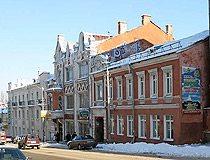
Architecture of Smolensk
Author: Andrey Dmitriev
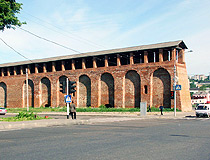
Part of the Smolensk Fortress Wall
Author: Kiyanovsky Dmitry
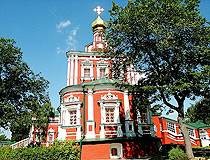
Novodevichy Convent in Smolensk
Author: Jan Erik Forss
Smolensk - Features
There are several versions of the origin of the name of Smolensk. According to one of them, it goes back to the name of the Smolnya River. Another version mentions the famous trade route “from the Varangians to the Greeks.” Residents of the town were engaged in the production of resin (“smola” in Russian) used to give boats greater strength. The pine forests in the immediate vicinity of the town favored the construction of boats and the production of resin.
The origin of the coat of arms of Smolensk is not known for certain. It was first mentioned in 1664. On the silver shield you can see the Gamayun bird (a prophetic bird of Russian folklore) on a black cannon with a golden gun carriage. The cannon symbolizes the city’s rich military history, its crucial border position. The bird of paradise Gamayun is a symbol of happiness and striving for it, peace, and rebirth after wars.
Smolensk is located about 400 km west of Moscow, in the upper reaches of the Dnieper River. The city has an advantageous geographical position on the routes from Moscow to Belarus, the Baltic states, countries of Central and Western Europe. It stretches 25 km from west to east and 15 km from north to south.
In the history of Russia, Smolensk is known as the “city-shield”, “shield of Russia” and “city-key”. For many centuries, it served as a reliable defense of Moscow protecting it from attacks coming from the western borders of the country. The City Day of Smolensk is celebrated on September 25 - in memory of the liberation of the city from the Germans on September 25, 1943.
The climate in Smolensk is moderately continental, softened by the influence of the Atlantic Ocean. Smolensk has cool, mostly rainy summers and rather prolonged moderately cold winters. The average temperature in July is plus 17.8 degrees Celsius, in January - minus 6.2 degrees Celsius.
Smolensk is a major transport hub of western Russia. The main cargo and passenger flows from the countries of Western Europe, the Baltic States, and Belarus pass through it. The city has a developed rail and highway connection with Moscow and St. Petersburg. Trains run through Smolensk to Minsk, Brest, Vilnius, Kaliningrad, Warsaw, Berlin, Prague, Vienna, Paris, Nice.
There is no navigation on the Dnieper River. There are also no civil flights to Smolensk. The city’s public transport is represented by three most common types of land transport - buses, trolleybuses and trams.
Favorable geographical position at the intersection of transport routes connecting Moscow and Western Europe, proximity to large industrial centers of Russia and to the European sector of the world market are the main competitive advantages of Smolensk. The border position of the Smolensk region predetermines the possibility of intensifying cross-border cooperation.
Main Attractions of Smolensk
Smolensk Fortress Wall (1595-1602). The Smolensk fortress was of great defensive importance in the Russian state. Most of it was destroyed by the retreating troops of Emperor Napoleon I on November 17, 1812, during the French invasion of Russia. Only 18 towers and about 3.5 km of wall fragments have survived to this day and have the status of an architectural monument. Barklaya-De-Tolli Street, 7.
Assumption Cathedral - a magnificent cathedral located in the central part of Smolensk on Sobornaya (Cathedral) Hill. It was built at the turn of the 17th and 18th centuries in memory of the heroic defense of Smolensk in 1609-1611, on the site of the 12th century cathedral of the same name.
During the wars of 1812 and 1914-1945, the building was not damaged. The iconostasis and decoration in the Kiev baroque style have been preserved inside. The observation deck located here offers beautiful views of Smolensk and the Assumption Cathedral itself. Sobornyy Dvor Street, 5.
Bolshaya Sovetskaya Street - one of the most beautiful streets in Smolensk stretching from the bank of the Dnieper River through the historic center of Smolensk, past Sobornaya Hill with the Assumption Cathedral. On this street, wealthy townspeople built their mansions and tenement houses during the times of the Russian Empire.
Today, almost every house that has been preserved on Bolshaya Sovetskaya Street is an architectural “gem” worthy of special attention. Most of the residential and office buildings facing the main street are recognized as monuments of architecture and history. Some of the buildings destroyed during the Second World War have been carefully restored to their original form using photographs and archival documents.
Deer Sculpture in Blon’ye Garden. In 1909, in the vicinity of his hunting lodge in Rominten Forest, Kaiser Wilhelm II, the last German Emperor, shot a deer with unusually gorgeous antlers. The emperor liked this hunting trophy so much that he decided to immortalize it in bronze. For this, the then famous sculptor-animalist Richard Frize was invited. In 1910, a sculpture was installed on a pedestal near the chapel of St. Hubert. The resulting bronze deer turned out to be about one and a half times larger than the original animal.
In 1944, the sculpture disappeared. One year later, it was discovered by the Red Army at the country house of Hermann Goering. After the war, this bronze deer was transported to Smolensk. In 1945, on the side of the trophy, one could still read the white ink inscription: “A gift from East Prussia to the children of Smolensk.” The sculpture was installed in the playground in Blon’ye Garden, a park in the city center. Glinki Street, 1.
Monument “Grateful Russia to the Heroes of 1812” - one of the most famous monuments in Smolensk erected in honor of the 100th anniversary of the Patriotic War of 1812 (the French invasion of Russia). It is made in the form of a rock about 10 meters high, on top of which two eagles protect their nest from the Gaul armed with a sword. The sculpture stands in the Heroes’ Memorial Park near the fortress wall. Dzerzhinskogo Street, 6.
Smolensk Art Gallery. This museum is located in the building, which is a monument of civil architecture of the 19th century. It displays collections of Russian and Western European art: paintings by Repin, Aivazovsky, Levitan, Benoit, Falk, Roerich, and other masters, as well as sculptures. There is also an extensive exposition of the Soviet period. Temporary exhibitions of contemporary artists are held here as well. Kommunisticheskaya Street, 4.
Historical Museum of Smolensk. The exhibitions of this museum are about the history of the Smolensk region from the Stone Age to the New Age. Here you can see ancient tools, medieval armor, weapons, coins, jewelry, household items, and much more. Lenina Street, 8.
Museum “Smolensk - the Shield of Russia”. It is open in Gromovaya (Thunder) Tower of the Smolensk fortress wall. The main part of the exhibition is devoted to the city’s military history. In 2002, an exhibition devoted to the construction of defensive structures was added. On the third tier of the tower there is a thematic exhibition “Soldier of 1812” consisting of outfits and weapons of the Russian and French armies of that time. Oktyabrskoy Revolyutsii Street, 3.
Attractions of Smolensk
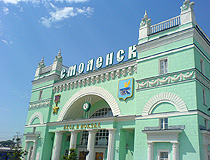
Smolensk Railway Station
Author: Kirill Afonin
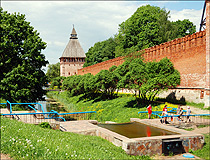
Another preserved part of the Smolensk Fortress Wall
Author: Olga Pozdina
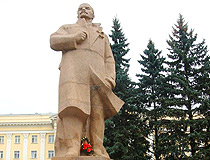
Monument to Lenin in Smolensk
Author: Kudinov D.M.
Museum “Smolensk Flax”. The history of the development of flax growing in the Smolensk region is presented in detail here (arable tools, tools for the cultivation and processing of flax, spinning wheels, Smolensk costumes with belts and headdresses). A separate part of the exposition is devoted to household items traditionally present in the Russian hut. The museum is located in Nikolskaya Tower of the Smolensk fortress wall. Marshala Zhukova Street, 6.
Sergey Konenkov Sculpture Museum. This famous Russian and Soviet sculptor born in the Smolensk region was often called “the Russian Rodin”. The museum was created on the initiative of the sculptor, who wished to exhibit most of his works in Smolensk. The collection is housed in a picturesque 19th century mansion in the city center. The exposition consists of 80 works on religious, revolutionary and everyday topics. Mayakovskogo Street, 7.
Museum “Smolensk Oblast during the Second World War” - one of the most visited museums in Smolensk located in the building of the former school “In Memory of 1812”. This two-story building in the neo-Russian style was erected in 1912, to commemorate the 100th anniversary of the Patriotic War of 1812. It is stylized as fortress towers - with battlements and loopholes.
The exposition includes items and documents showing the role of Smolensk in the history of the war. The collection of military artifacts contains valuable archival documents and photographs, weapons and military uniforms, banners and awards, soldier’s household items and trophies from Germany. Wartime military equipment is on display in front of the museum. Dzerzhinskogo Street, 4A.
Church of the Apostles Peter and Paul (1146) - one of the three preserved monuments of pre-Mongol architecture in Smolensk located near the building of the railway station. The ascetic design of this building corresponds to the canons of church building adopted in Rus before the Mongol invasion. Kashena Street, 20. The Church of Archangel Michael (1191-1194), another well-preserved pre-Mongol church, is also noteworthy. Parkovaya Street, 2A.
Lopatinsky Garden - one of the oldest parks in Smolensk. The park was laid out by order of the governor Alexander Lopatin in 1874. Today, there are a lot of interesting things in the park: a pond and an embankment, a corner for lovers, an alley of peace, a section of the fortress wall with towers, art benches decorated with various figured lanterns, models of Smolensk architectural monuments, and much more. Lenina Street, 2A.
Historical and Architectural Complex “Teremok” in Flenovo. It is located southeast of Smolensk in the former estate of the Tenishev princes - collectors and patrons of art, who played an important role in the cultural life of Smolensk and Russia.
At the turn of the 19th - 20th centuries, Maria Tenisheva created an art center here, which later became known not only in Russia, but also in Europe. Tourists are invited on excursions to places visited by famous painters and musicians. The artists I. Repin and M. Vrubel worked here. It was visited by F. Chaliapin and I. Stravinsky. Above the portal of the church there is a mosaic made by Nicholas Roerich.
Memorial Complex “Katyn” - an international memorial to the victims of political repression located in the Katyn forest to the west of Smolensk. On the territory of the memorial there is a military cemetery, where 4,415 Polish prisoners of war are buried (mostly officers). Prisoners of the Kozelsk concentration camp, they were shot by officers of the NKVD of the USSR in the spring of 1940. Other burials include about 6.5 thousand victims of Stalinist repression of the 1930s and 500 Soviet prisoners of war executed by the German occupation forces in 1943.



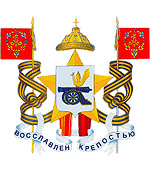
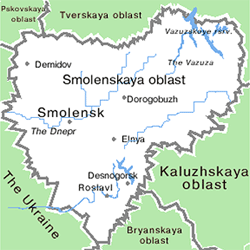






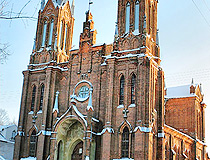
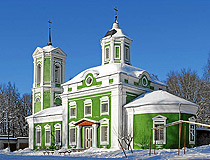
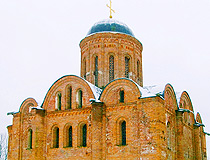
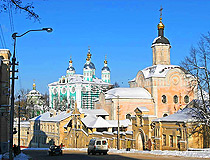
The comments of our visitors